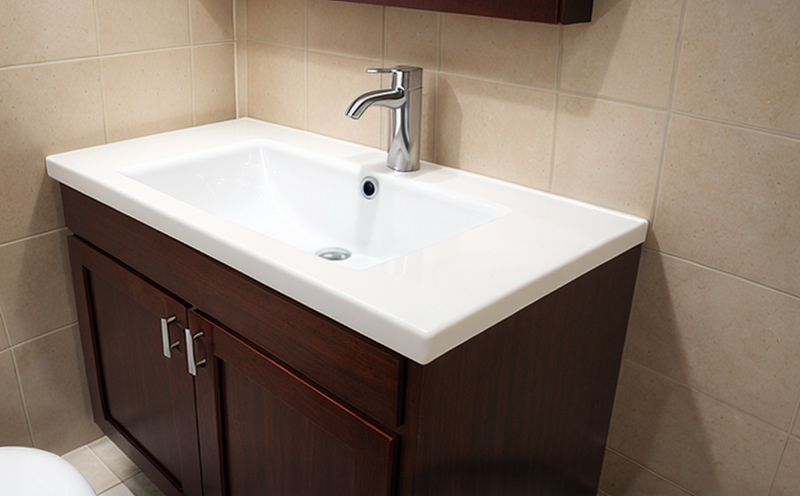IEC 60695 Fire Hazard Testing of Sanitary Plastic Equipment
The International Electrotechnical Commission (IEC) Standard IEC 60695-11 is a critical part of ensuring the safety and reliability of materials used in electrically operated devices, including those found in bathrooms and sanitary applications. This standard provides stringent guidelines for assessing the flammability properties of materials that might come into contact with electrical components. In the context of bathroom and sanitary plastics testing, this means evaluating how these materials perform under controlled fire hazard conditions.
The importance of IEC 60695-11 in the sanitary sector cannot be overstated. It ensures that products like showerheads, bidets, and water tanks are safe from ignition hazards due to their proximity to electrical components or potential exposure to high temperatures during manufacturing processes. This testing is particularly crucial for materials such as ABS (Acrylonitrile Butadiene Styrene), PVC (Polyvinyl Chloride), CPVC (Chlorinated Polyvinyl Chloride), and other engineered plastics commonly used in bathroom fixtures.
During IEC 60695-11 testing, samples are exposed to high temperatures or radiant heat sources under controlled conditions. The goal is to determine the material's ability to withstand ignition without spreading flames or releasing toxic gases that could pose a hazard. The test simulates real-world scenarios where materials might be subjected to extreme temperatures during production or installation.
The testing process involves several key steps, each designed to assess different aspects of fire resistance:
- Horizontal Burning Test (HB): This evaluates the material's ability to resist ignition when placed horizontally and exposed to a flame from an igniter. The test measures both the time it takes for the sample to ignite and the distance the flame travels along its surface.
- Vertical Ignition Test: In this test, vertical samples are subjected to a flame source. It assesses the material's resistance to ignition when installed vertically in a position that mimics real-world applications like wall-mounted fixtures or standing shower units.
The results of these tests provide critical data on the flammability and fire spread characteristics of plastic materials used in bathroom and sanitary products. Compliance with IEC 60695-11 standards ensures that manufacturers can confidently design and produce safe, reliable products that meet international safety requirements.
For quality managers and compliance officers, understanding these tests is essential for ensuring product safety and regulatory compliance. By adhering to these standards, businesses can mitigate risks associated with fire hazards in their products, thereby protecting end-users and maintaining a positive brand reputation.
Why It Matters
The IEC 60695-11 fire hazard testing is not just about compliance; it's about safeguarding public safety. By ensuring that materials used in bathroom and sanitary plastics meet these stringent standards, manufacturers can prevent fires caused by ignition of plastic components during installation or use. This is particularly important given the increasing trend towards more modern, electrically operated fixtures.
Failure to comply with these standards could lead to hazardous situations, including injuries or fatalities due to fire outbreaks. Additionally, non-compliance may result in product recalls and legal liabilities for manufacturers. Therefore, investing in IEC 60695-11 testing is not just a regulatory requirement but also a responsible business practice.
For R&D engineers and procurement teams, understanding the significance of these tests can help drive innovation and sourcing decisions that prioritize safety and performance. By incorporating fire hazard testing into their product development processes, manufacturers can ensure that their designs are robust enough to meet both current standards and future regulatory requirements.
In conclusion, IEC 60695-11 fire hazard testing is vital for ensuring the safety of bathroom and sanitary plastic materials. It plays a crucial role in preventing fires caused by ignition hazards and protecting public safety. Compliance with these standards not only meets legal obligations but also contributes to building trust with consumers and stakeholders.
Quality and Reliability Assurance
The quality and reliability of bathroom and sanitary plastic products are paramount for manufacturers, especially when it comes to materials that may come into contact with electrical components. Ensuring the safety and longevity of these products requires rigorous testing and adherence to international standards like IEC 60695-11.
Thermal Stability: During production, materials must be tested for their thermal stability under high temperatures. This ensures that they do not degrade or pose a fire hazard when exposed to elevated heat during manufacturing processes.
Surface Integrity: The surface integrity of plastic components is crucial for maintaining the aesthetic appeal and functionality of bathroom fixtures. Testing helps identify any defects in the material's surface that could compromise its performance over time.
By incorporating these tests into their quality assurance processes, manufacturers can ensure that their products meet not only IEC 60695-11 standards but also broader industry expectations for reliability and durability. This commitment to quality enhances customer satisfaction and fosters long-term relationships with stakeholders.
International Acceptance and Recognition
The IEC 60695-11 fire hazard testing is widely recognized across the globe, ensuring that products meeting these standards are accepted in various markets. Countries like Australia, Canada, Europe, Japan, and the United States all have regulations that align with or reference this standard.
Manufacturers who comply with IEC 60695-11 gain international acceptance for their products, making it easier to penetrate global markets without additional testing requirements. This is particularly beneficial for small and medium-sized enterprises (SMEs) looking to expand internationally.
The widespread adoption of this standard underscores its importance in the industry. By adhering to these rigorous fire hazard tests, manufacturers can demonstrate their commitment to product safety and reliability, thereby gaining a competitive edge in the global marketplace.





